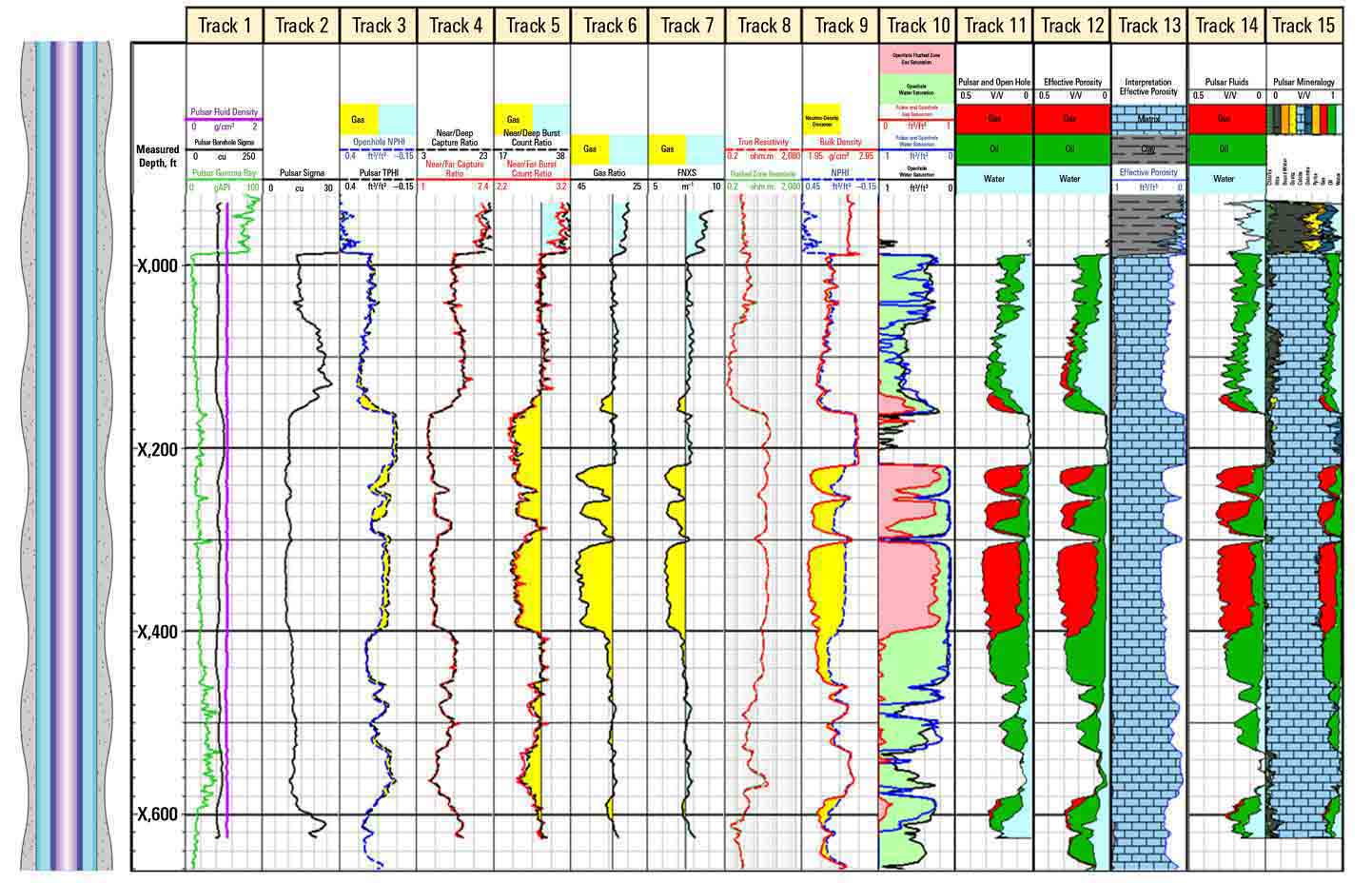Attain comprehensive formation evaluation in cased hole: one run, one tool.
Water-Alternating-Gas Saturation Monitoring in a Single Cased Hole Logging Run, Abu Dhabi
Published: 06/14/2017

Water-Alternating-Gas Saturation Monitoring in a Single Cased Hole Logging Run, Abu Dhabi
Published: 06/14/2017

Cased well saturation monitoring for WAG injection
An operator drilling in a giant onshore oil field in Abu Dhabi is targeting thick, porous Cretaceous shelf carbonate reservoirs bounded by a shaly formation at the top, which acts as a regional seal. To enhance oil recovery, both water and gas are injected in the reservoirs in water-alternating-gas (WAG) cycles. To monitor the water and gas saturation across the uppermost reservoirs, the operator needed to log in the brine-filled injector well, which had both 7-in casing and 3 1/2-in tubing.
Complete formation evaluation in one cased hole run
In introducing stand-alone petrophysical volumetric interpretation incorporating high-fidelity mineralogy and lithology for cased holes, Pulsar multifunction spectroscopy service is also providing the new fast neutron cross section (FNXS) measurement that definitively differentiates gas-filled porosity from liquid-filled zones and tight formations. The fast neutron inelastic scattering response used to calculate FNXS is not dominated by particular elements, which is the case for conventional neutron logging. With its measured values for rock matrix and water in the same range, the FNXS measurement is insensitive to variation in liquid-filled porosity but highly sensitive to variation in gas-filled porosity.
Accurate one-run differentiation of gas-filled porosity from nonporous carbonate
The well designated for monitor logging was completed as a horizontal water injector, but the zone of interest for the logging operation was in the slanted section (60° average deviation) that builds angle for the lateral. Openhole logging while drilling (LWD) (Tracks 8 and 9)—conducted 3 years before the monitor logging with Pulsar service—indicated a zone of gas-filled porosity from X,220 to X,400 ft. The well had been completed with 7-in casing and 3 1/2-in tubing in the 8 1/2-in wellbore. There were no open perforations in the slant section.
Tracks 4, 5, and 6 show the basic pulsed neutron logging ratios obtained with Pulsar service. The thermal near and far ratios in Track 4 are computed from capture counts and used to compute the thermal neutron porosity (TPHI, Track 3). The profile of the thermal ratios is similar to that of the inelastic "burst" count ratios in Track 5 and they correlate well with the computed TPHI because all these measurements are strongly influenced by the hydrogen index of the formation. This bias means that they cannot distinguish very low porosity from gas-filled porous intervals. Therefore, conventional pulsed neutron logging requires externally provided porosity measurements.
The thermal and inelastic ratios indicate gas (yellow shading) not only in the gas-filled porosity zone identified by openhole LWD (Tracks 8 and 9) from X,220 to X,400 ft but also well into the overlying section. However, the gas ratio output from the fast inelastic count rate measured with the farthest-spaced detector on the Pulsar service tool and the resulting wellbore-corrected FNXS measurement (Tracks 6 and 7, respectively) show a distinctly different response. They read high in the known gas-filled porosity zone and in the interval from X,140 to X,160 ft but are consistent at about the 7.5-m–1 theoretical value for limestone elsewhere in the reservoir, including a 0-pu zone (X,160 to X,220 ft) and water- or oil-filled zones with varied porosity (X,000 to X,140 ft and X,400 to X,580 ft).

Although the gas flagged by FNXS at X,140 to X,160 ft is not shown on the openhole logs made 3 years earlier, it is confirmed by crossover of the open- and cased hole porosities in Track 3. This could be gas trapped by a permeability barrier such as a stylolite. Pulsar service's porosity has a stronger gas effect than the openhole thermal neutron porosity (NPHI) because the LWD measurements were affected by drilling mud invasion.
The interpretation of the openhole logs in Tracks 12 and 13 computes the hydrocarbon volume from resistivity and approximates oil and gas from the neutron-density separation. Because FNXS uses well-defined end points for fluids and minerals and follows a linear mixing law, the gas volume can be quantified with a solver routine. Track 11 corresponds to a conventional cased hole fluids analysis by integrating openhole NPHI and mineral volumes with sigma, TPHI, and FNXS from Pulsar service. Sigma (Track 2) is the prime driver for the water volume, and TPHI and FNXS are the basis for differentiating oil and gas.
However, Pulsar service does not require openhole log information to deliver a complete stand-alone cased hole analysis. As shown in Tracks 14 and 15, by combining sigma, TPHI, and FNXS with the quantitative elemental dry weights obtained by Pulsar service spectroscopy, one cased hole logging run of Pulsar service provides a complete dataset for the operator to monitor gas and water saturations in the carbonate reservoirs.
Challenge: Efficiently and accurately monitor water and gas saturations in carbonate reservoirs with varied porosity and fluid content to optimize injection cycles.
Solution: Deploy Pulsar multifunction spectroscopy service to provide a full petrophysical volumetric interpretation including definitive differentiation of gas-filled porosity from liquid-filled porosity and tight zones.
Results: Quantified gas, water, and oil saturations in a single logging run to quickly and accurately monitor injection cycles.
